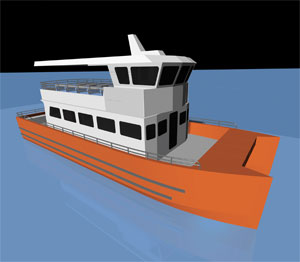Working on behalf of an Alaska whale-watching tour operator, shipbuilders and technicians have designed the nation’s first all-electric seagoing passenger vessel.
Tongass Rain, the planned 50-foot catamaran, will run on battery, wind and solar power, with no petroleum-based propulsion. Armstrong Marine of Port Angeles, Wash., is prepared to construct the catamaran for Tongass Rain Electric Cruise LLC. The company plans to use the 47-passenger boat for tours at Juneau.
Unlike other electric vessels, the Tongass Rain concept has no combustion-based backups. It will run primarily on batteries and rely on solar and wind power when its batteries are depleted. It will be powered by twin Elco EP-10000 engines. These engines are more than powerful enough for the catamaran, which should be able to reach a top speed of 12 knots with ease.
Tongass Rain is only the first of several planned electric vessels, all of which were designed by Scott Jutson, a naval architect whose specialty is high-efficiency hulls for minimal fuel use and long-range capacity. Jutson said the Alaska boat is a step forward into a new world of electric vessels.
“What makes Tongass Rain unique is that it’s the first in a new era of electric vessels in North America that will have Coast Guard Subchapter T certification for passengers,” Jutson said. Although there are a few fully electric ferries in North America, Tongass Rain will be the first all-electric vessel that is structurally rated for open-water passenger carrying.
Armstrong Marine has worked closely with Tongass Rain owner Bob Varness, the man behind the concept, and the shipyard said it plans to build the vessel. Sales representative John Armstrong said the operator is still working on securing the financing.
Varness said both companies feel that all-electric vessels are the future, and he wants to prove to the world just how efficient and affordable these all-electric boats can be. The company plans to use the vessel to educate green-minded tourists by providing regular whale-watching tours that show how the boat is breaking new ground.
Varness, a veteran of the battery systems industry, said the decision to build the vessel came from a deep respect for the environment, specifically in Juneau, where Varness has watched the growth of the whale-watching industry and its effect on the ocean and air quality.
“There used to be about 12 whale-watching boats in Juneau,” Varness said. “Now it’s an industry. They use 70-footers. When the whale-watching ships come back in at the end of a day, there’s a haze on the water.”
Beyond lessening the stress on the environment from all that engine exhaust, Varness said Tongass Rain would be able to make the trip out to good whale-watching areas more efficiently than other vessels because the batteries can be precision-charged for a plotted sightseeing route.
The design is named for the nearby Tongass National Forest, the largest national forest in the U.S.
Varness is confident that the cutting-edge battery system in Tongass Rain represents the future of marine propulsion. “The new technology is getting close to replacing fuel. It’s developing so fast,” he said. “A year ago this wouldn’t have been possible.”

